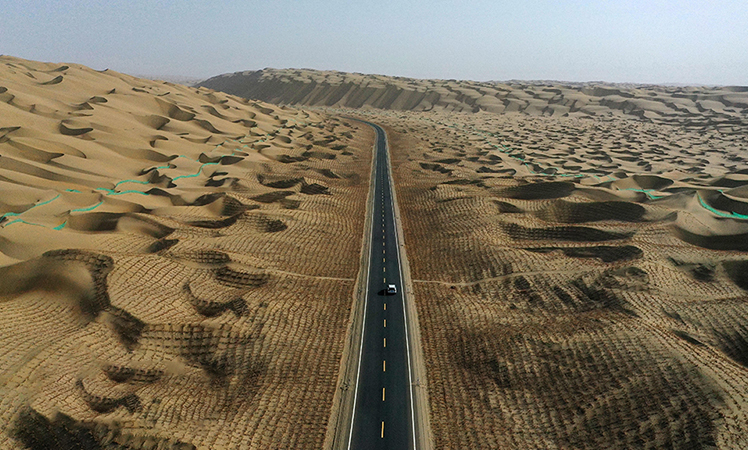China makes ecological protection more efficient with digital technology
The prospering digital economy is gradually becoming a solid foundation supporting economic and social development, as internet, big data, cloud computing, artificial intelligence (AI), blockchain and other new technologies are seeping into industries.

Yangtze finless porpoises are seen swimming near the Gezhouba Dam in Yichang, central China’s Hubei province, May 10, 2022. (People’s Daily Online/Liu Shusong)
For ecological protection, the digital economy not only leads to higher efficiency, but also brings protection and monitoring data collected by nature reserves over the years to effective utilization, which prove the huge potential of digital technology in this specific area.
Inspur, a leading cloud computing and big data services provider from China, has developed a monitoring and warning system for Asian elephants in cooperation with the forestry and grassland administrations of Yunnan province and the province’s Xishuangbanna Dai autonomous prefecture, as well as the Management and Protection Bureau of Xishuangbanna National Nature Reserve, which tracks in real time the conditions, numbers, and locations of elephant herds.
Front-end sensing devices under the system capture images and use AI technology to identify animal species. The system then generates warnings through edge computing, which will be sent to villagers and surrounding people via smart radio, telephone applications, and other media forms for precaution.
“So far, the identification rate for Asian elephants has been improved to over 99 percent. Even only a tail of an elephant was captured in the night, we can track the trace of the herds,” said Sun Yonghao, vice general manager of Inspur’s natural resources business division.
It is the first solution to combine AI recognition technology with wildlife monitoring and warning. Since being launched in 2020, it has sent over 9,000 messages of warning, playing a crucial role in relieving human-elephant conflicts and promoting biodiversity.
Inspur’s system is not the only application of digital technology application in the ecological protection sector.
At the Tian-e-zhou Baiji National Reserve in Shishou, central China's Hubei province, water temperature, pressure and dissolved oxygen rate, as well as the intake, excrement forms, and skin smoothness of Yangtze finless porpoises are recorded and presented on a big screen. The data are constantly updated.

An adult crested ibis and two young birds rest on a tree near the Juhe River, Yaozhou district, Tongchuan, northwest China’s Shaanxi province, May 6, 2022. (People's Daily Online/Shi Tonggang)
At the Northeast China Tiger and Leopard National Park, which spans an area of over 1.4 million hectares in the northeastern provinces of Jilin and Heilongjiang, an integrated monitoring system that employs infrared cameras, a remote sensing satellite and patrolling drones has captured over 20,000 images of Siberian tigers and Amur leopards.
Digital technology not only helps precisely identify and timely track emerging ecological issues, but also promotes coordinated development of the digital economy and green economy.
In southwest China’s Guizhou province, a digital platform is monitoring in real time the restoration progress of the ecological environment of all mines across the province. In Hangzhou, east China’s Zhejiang province, specially-designed drones that are able to sample water and analyze 18 kinds of gases have effectively improved the city’s capability of environment monitoring.
Turning manual disposal to smart monitoring and passive response to active forewarning, the digital technology is fully demonstrating its competence in ecological and environmental protection.

Photo taken on March 28 shows a control room of a waste incineration power plant in Qiaodong district, Zhangjiakou, north China's Hebei province. (People's Daily Online/Cen Yi)
According to the 14th Five-year (2021-2025) Plan, China will drive the reform of production mode, lifestyles and governance model with digital transformation. A series of documents released by the central government of China also request the country to build a smart and efficient information system for ecological management and promote digital transformation in the sector of ecological and environmental protection, so as to improve environmental capacity, suitability of spatial development and rationality of resource utilization.
China is fully tapping into the potential of digital technology in its innovative practice of ecological protection and green development. China will make its development greener and more prosperous as it pursues high-level ecological protection and modernization of ecological governance.
Photos
Related Stories
- China to increase effective ecological investments
- China sees marked progress in marine conservation
- China’s Yellow River Delta sees ecological improvement
- Factbox: China's ecological progress in 2021
- China to take targeted, scientific measures for new pollutants disposal: official
- Yongnianwa Wetland Park in Hebei provides ideal habitat for wild birds after decade of ecological restoration efforts
- China's ecology sees historic turning point: official
- China's ecology sees historic turning point: official
- China actively promotes environmental protection for half a century: minister
- Xi's thought boosts global ecological governance
Copyright © 2022 People's Daily Online. All Rights Reserved.









